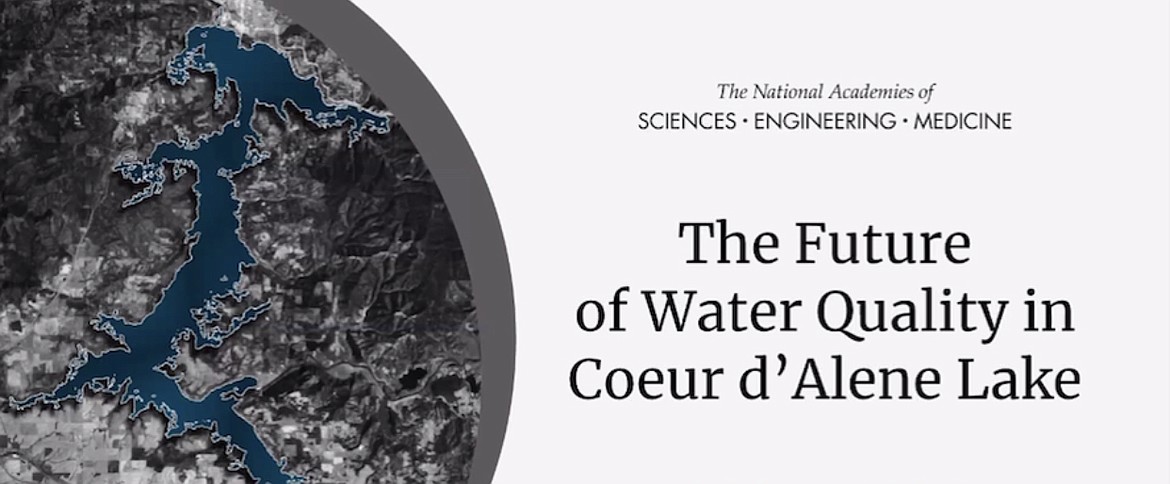Coeur d'Alene Lake study resumes Monday
The National Academy of Sciences Committee on the Future of Water Quality in Coeur d'Alene Lake will host its third virtual public meeting on Monday at 10 a.m.
This session will feature a U.S. Environmental Protection Agency presentation.
Since starting the study last year, the committee has conducted two meeting series with federal, state, and local agencies to discuss water quality data and analyses pulled over the last few decades.
The committee is part of a two-year, $770,000 study initiated by the state of Idaho after water quality triggers outlined in the 2009 Coeur d'Alene Lake Management Plan were either approached or exceeded.
Kootenai County and the EPA are co-sponsors of the study, and the Coeur d'Alene Tribe supports the review.
Some of the "triggers" evaluated in the study include the levels of metals, nutrients, and other influences in the lake that could lead to unwanted impacts on the water quality and ecological health.
"The expectation is that the data review will enable the NAS committee to draw conclusions about trends in water quality," an NAS piece published by the Press in March said. "This will include whether sufficient data has been collected to address possible adverse or catastrophic events in the Lake."
In May, the latest NAS meeting primarily focused on Lake Coeur d'Alene's phosphorus levels and its origins from Kootenai County tributaries — the Coeur d'Alene and St. Joe rivers.
Craig Cooper, a limnologist with the Idaho Department of Environmental Quality, broke down data from the Coeur d'Alene Basin that showed a 200% increase (25 tons to 75 tons) in the lake phosphorus levels between the 1990s and 2000s.
Cooper's presentation reported 85.5% of the total 180 tons of phosphorus deposited annually in the lake today comes from those two rivers alone.
According to the EPA, high concentrations of phosphorus concern experts. It can lead to algae and aquatic plant growth, which causes decreased oxygen levels, a process more formally known as eutrophication. The algae bloom offsets the amount of healthy oxygen that keeps heavy metals on the lake floor instead of near aquatic life and human recreation.
According to NAS, phosphorus is derived from soil, animal and human waste, and fertilizers. Cooper said in May that specialists suspect the phosphorus uptick could be caused by changes in soil chemistry, land use, climate-related changes, significant flood events, and hazardous metal deposits.
"Our everyday activities present us with ample opportunity to reduce our phosphorus footprint," the NAS piece said. "Simple things like disposing of pet water properly, washing your car on the lawn or at a car wash instead of on pavement, using fertilizers conservatively, and waiting for what flows into the gutter (and eventually to the Lake, river, or aquifer) can make a big difference. It may not seem like much, but if we all do little things every day, it can add up quickly and significantly. It benefits our waterways and all who enjoy them."
No formal recommendations for remedial action, if needed, will come from the committee. However, if the state requests further action, another study could be conducted in the future.
The NAS's designated tasks for the committee are to:
• Evaluate current water quality in the lake, lower rivers, and lateral lakes, focusing on observed trends in nutrient loading and metal concentrations while considering how changes in temperature or precipitation could affect those trends.
• Consider the impacts of current summertime anoxia on the fate of the metals and nutrients.
• Consider whether reduced zinc levels entering the lake resulting from the upgrade to the Central Treatment Plant and other upstream activities remove essential control on algal growth.
• Discuss whether the metal found in the lake sediments will be released into the lake if the current trends continue.
• Discuss the relevance of metals released in the lake to human and ecological health. If sufficient data is not available, the National Academies will identify the additional data required to achieve an appropriate confidence level.
Registration for the webinar is available at: www.nationalacademies.org on the Future of Water Quality in Coeur d'Alene Lake webpage.

